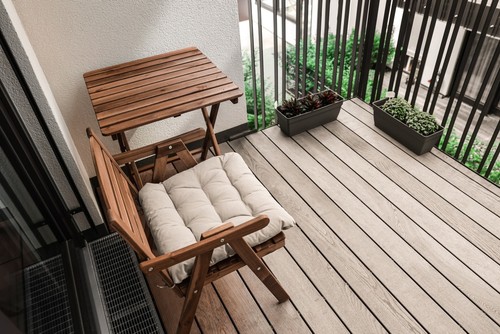
Carpet Flooring for Bedrooms: Elevate Your Home Comfort
October 31, 2023
Outdoor Flooring Options for Patios and Balconies
December 29, 2023
Maintaining Bamboo Floors: Best Practices. Bamboo flooring has become increasingly popular due to its eco-friendliness and unique aesthetic.
Homeowners are drawn to its sustainability and the warm, natural look it brings to interiors.
Proper maintenance is crucial for bamboo floors. It preserves their appearance and ensures longevity, protecting your investment.
Table of Contents
Characteristics of Bamboo Flooring
Bamboo is a renewable resource known for its strength. Bamboo floors are made from stalks, which are harvested, processed, and transformed into flooring planks.
Bamboo floors offer benefits like sustainability and durability, but they can be vulnerable to scratches and moisture damage. Understanding these characteristics is vital for maintenance.
Initial Care Post-Installation
After installation, clean bamboo floors gently to remove installation residue. Avoid excessive moisture during this stage.
Allow floors to acclimate to the environment for several days post-installation. Avoid heavy furniture placement during this period.
Daily Cleaning and Maintenance

Effective Daily Cleaning Techniques
To maintain your bamboo floors on a daily basis, it’s essential to sweep or use a microfiber mop regularly to remove dust, dirt, and small debris.
These simple yet effective cleaning methods prevent the accumulation of particles that can cause scratches and wear over time.
Choosing the Right Cleaning Tools and Products
Selecting the appropriate cleaning tools and products is crucial. Opt for pH-neutral bamboo floor cleaners, which are gentle on the finish and the bamboo material itself.
Additionally, avoid using excessive water during cleaning, as prolonged exposure to moisture can lead to warping or damage.
Tips to Avoid Scratching and Damage
Preventing scratches and damage involves several measures. Consider placing doormats at entrances to capture dirt and grit from shoes.
Encourage family members and guests to remove their shoes indoors to prevent abrasive particles from being tracked onto the floor.
Furthermore, using furniture pads under the legs of chairs and tables is essential to avoid unsightly scratches and scuffs.
Dealing with Spills and Stains
- Immediate Actions for Spills
When spills occur, it’s essential to act promptly. Use a clean, dry cloth to blot the spill gently, avoiding excessive rubbing, which can damage the floor’s finish. For sticky substances, consider gently scraping them off with a plastic scraper.
- Removing Common Stains from Bamboo
Different stains require specific treatments. For food or beverage stains, create a mixture of mild dish soap and warm water for cleaning. For more stubborn stains like ink or markers, specialized bamboo floor stain removers may be necessary.
- Preventing Water Damage
Preventing water damage is crucial. Wipe up spills as soon as possible and avoid using wet mops for cleaning. A damp (not soaking wet) mop is suitable for bamboo floors.
Preventive Measures for Longevity

Using Rugs and Mats Strategically
Strategically placing rugs and mats in high-traffic areas can significantly reduce wear and tear on your bamboo floors. Opt for non-slip and breathable options to protect the flooring while maintaining air circulation.
Furniture Pads to Prevent Scratches
To prevent scratches and scuffs caused by furniture, consider using protective pads under the legs of chairs and tables. These simple additions can go a long way in preserving the pristine look of your bamboo floors.
Controlling Indoor Humidity and Temperature
Maintaining a stable indoor environment is crucial for bamboo floors. Extreme fluctuations in humidity and temperature can lead to warping or cracking. Use humidifiers and dehumidifiers as needed to maintain ideal conditions.
Deep Cleaning Bamboo Floors
Deep cleaning should be scheduled periodically to remove built-up grime and restore the floor’s shine, typically every few months or as needed. This involves using a damp mop with a suitable bamboo floor cleaner.
Avoiding excessive moisture and harsh chemicals during deep cleaning is crucial, as they can damage the floor’s finish. Using a damp mop and a bamboo floor-specific cleaner is recommended.
Overwetting the floor and using steam cleaners should be avoided during deep cleaning, as excessive moisture can lead to warping and other damage.
Polishing and Refinishing Bamboo Floors

Polishing should be done annually to renew the floor’s shine. Choose a bamboo floor polish compatible with the flooring material.
Refinishing is a more intensive process that involves sanding and reapplying the finish. It’s recommended to seek professional services for this to ensure proper execution.
Due to the complexity and specialized equipment involved, professional services are often the best choice for refinishing bamboo floors.
Repairing Damaged Bamboo Flooring
Identifying Types of Damage
It’s essential to recognize various types of damage, including scratches, dents, and moisture-related issues.
Scratches can be shallow or deep, dents may affect the surface or go deeper, and moisture damage can result in warping or discoloration. Accurate identification informs the appropriate repair approach.
DIY Repair Tips
Consider using a bamboo floor repair kit or a color-matched wood filler for minor scratches. However, extensive damage or issues like warping and deep scratches should prompt professional repair services, ensuring the best results and floor longevity.
Sustainable Practices in Bamboo Floor Care
Opt for eco-friendly, non-toxic cleaning products that are safe for your bamboo floors and the environment. These products are gentle yet effective in maintaining the floor’s appearance.
Consider adopting sustainable maintenance practices, such as using reusable cleaning tools and minimizing waste by choosing refillable cleaning solutions. These choices align with eco-conscious living and help reduce the environmental impact of floor care.
Frequently Asked Questions
How often should bamboo floors be cleaned?
Bamboo floors should be swept or cleaned daily to remove dust and debris. Deep cleaning can be done every few months or as needed.
Can bamboo floors be mopped?
Yes, bamboo floors can be mopped, but it’s important to use a damp (not soaking wet) mop and a pH-neutral bamboo floor cleaner to avoid damage.
What are the best products for cleaning bamboo floors?
Choose pH-neutral bamboo floor cleaners and non-abrasive cleaning tools. Avoid harsh chemicals and excessive moisture.
How to repair scratches in bamboo flooring?
For minor scratches, use a bamboo floor repair kit or color-matched wood filler. Extensive damage may require professional repair.
Is bamboo flooring suitable for high-humidity areas?
Bamboo flooring is sensitive to humidity fluctuations, so it’s best to maintain stable indoor humidity levels in high-humidity areas.
Maintaining Bamboo Floors: Best Practices – Conclusion

In conclusion, maintaining bamboo floors involves daily cleaning, preventive measures, deep cleaning, and occasional refinishing. Sustainable practices and eco-friendly products contribute to a greener home environment.
Proper maintenance ensures the longevity and beauty of bamboo floors, making them a sustainable and aesthetically pleasing flooring choice.
Promoting sustainable practices and educating homeowners about bamboo’s eco-friendliness fosters a culture of responsible and effective floor care.
Are you seeking professional and reliable flooring experts in Singapore? Contact us today!



